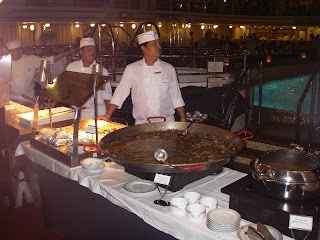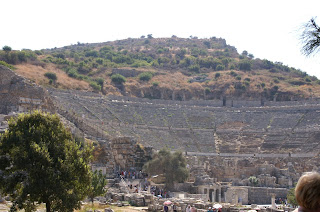Sunrise over Kusadasi on Wednesday morning
Today was a day of firsts: our first visit to Turkey and our first experience with a privately booked excursion. As you can see from the picture, the first part started out well.
The attraction of Kusadasi is its proximity to the ruins at Ephesus, where history says Mary and several of the Apostles fled after the events of Easter to escape persecution. Many people have suggested to us in the past that private excursions are better than ship-sponsored excursions - just you, a guide, a driver and your own vehicle - so Larry had booked us one through a company recommended by friends from Crystal. Promptly at 8:30 we walked out of the terminal to find our guide waiting to take us to our bus. This is definitely the way to take a tour! A ten passenger Mercedes mini-bus for the five of us, with lots of room for Mitch to sleep on the way to the ruins! Too bad it was only a 15 minute drive!
Our guide, Mehmet, was a historian by training and a real pro as a guide. The advantage of a private tour is flexibility, as we soon found out. On the drive over Mehmet told us we were one of five ships “in town” (with about 10,000 passengers between them) that day and he would adjust the route “on the fly” depending on crowds. A ship’s tour has to follow the route. Period. One of our planned visits was the Virgin Mary House and a call by Mehmet confirmed most of the buses had not yet arrived, so that became our first stop.
According to the New Testament, the Apostle John brought Mary to Ephesus after Christ’s ascension. The story goes that years ago a German nun had some ‘visionary dreams’ where she saw the location of the house Mary came to live in. An archaeological examination found evidence that there was a house there, and what now stands is a reconstruction of the building, which has become a shrine for pilgrims.
Common legend has it that if you take seven sips from one of the springs outside, that your sins for the last seven years will be forgiven. This only works for seven years, though - Mehmet pointed out that extra sips will NOT get you retroactive forgiveness beyond seven years. You can also leave wishes written on small pieces of paper tied to a wall near the house - sort of the Christian equivalent to the Western Wall in Jerusalem.
Our next stop was to be Ephesus itself, but on the way out, the wisdom of a private tour was confirmed. Over 50 full-sized tour buses packed every inch of the four parking lots and were lined up past the entrance to get in!
Ephesus was a trading city along the Silk Road and existed from 1400BC to 700AD, reaching its peak in about 200AD. Mehmet explained that the ruins were first discovered, quite by accident, in the 1930’s by a British company building a railroad. He told us that “discovered” really wasn’t the best way to describe it as the location was well-known, just no one had ever excavated it. Unlike Pompeii or other ancient cities, Ephesus was not “destroyed”. Rather, it was abandoned when the bay it was located on became completely silted in. While it had originally been a “harbour town” it is now some 15 miles inland from the Med. Over time Mother Nature had reclaimed the site, sort of like what would happen “if you didn’t dust your TV for 1300 years” was the way he put it.
By the time we arrived the buses that had not gone to the Mary House had arrived at Ephesus, so the crowds were just a little bit crazy. Which is a bit like saying The Great Flood was a scattered shower! The city was built into a hill and the picture below was taken from about a third of the way down. It shows the Celsus Library, the principal ruin, and a small portion of the “The Flood” of tourists!
While many of the best pieces were plundered (mostly by the Brits during their excavations) there are still numerous of them - temple friezes and columns, particularly - that have been dedicated to many of the Greek and Roman gods, such as Hercules and Nike (goddess of victory - so now you know where the brand name comes from!!). Oddly enough, her statue had no ‘swoosh’ symbol, nor did we see ‘Just Do It’ carved anywhere on the stone.
The best preserved part of the site is the ‘terrace houses’ which were first excavated in the late 1960s. These were the homes of wealthy (the Forest Hill of Ephesus) as evidenced by their immense size and the many ornate frescoes and mosaic floors they contained. After the site was first excavated, it was quickly decided that the site had to be protected from “the elements” or the artwork would be lost. As a result an enormous steel-framed canopy covers the entire area and a series of stairs and catwalks give you a great vantage point for taking pictures.


After exiting the terrace house our last stop was the Great Theatre. In its time in could hold as many as 50,000 people and it is said that St Paul and other of the Apostles preached there. It is still used today for concerts with the likes of Yanni, Elton John and Zamfir performing. The “lower bowl” can easily accommodate 20,000 people according to Mehmet, who has attended concerts there, and the acoustics are such that microphones are not required.
We now pause for lunch in a small town at 1500 feet elevation. This town, Srenice, actually dates back to 700AD, and many of the houses now standing are around 150 years old. Lunch was in a restaurant that had been a school house, and included salad, plates of ‘mezzes’ or small appetizers, and a mixed grill of chicken and lamb skewers and a Turkish specialty pumpkin dessert.
 |
| Norm and Mehmet at lunch. Looks appetizing, doesn't it? |
After lunch, and a brief stop at the Ephesus Museum, Mehmet told us our last stop would be a “Turkish carpet demonstration”. Now this was not on our tour agenda and caused Larry some amusement as he had been told to expect this as these so called “spontaneous” suggestions from guides happen on EVERY tour in Kusadasi. Ours was visit to Topkapi, the best Turkish Carpet House in town and, to be fair, it was an interesting stop. We were given a demonstration of the silk production process, from cocoon to thread to rug, as the pictures show.
 |
| The age old silk-spinning process, now becoming a dying art. |
This was followed by “the flying carpet” demonstration, otherwise known as “the hard sell”!! First they get you comfortable, get you a nice drink or cup of apple tea, and then proceed to roll out rug after rug for your inspection. There had to be at least 30 rugs rolled out and even our “host” had to duck under the low ceiling beams by the time it was done as he was standing on at least eight inches of carpets! While they tried very hard to sell Norm and Barb floor rugs, in the end Monica bought a small 100% silk piece to use as a wall hanging. After thanking Mehmet for a great day we returned to the ship.
We didn't really know what to expect of Turkey, perhaps something a bit more like Saudi Arabia? What we got was a very European country that is incredibly clean and very orderly. What we especially like are their tourist "truth in advertising" laws.........
Tomorrow is our second sea day (and a chance to finally catch up on our sleep) and is also Norm’s 55th birthday. He now qualifies for Senior’s Rates on most cruiselines!!!!!























































